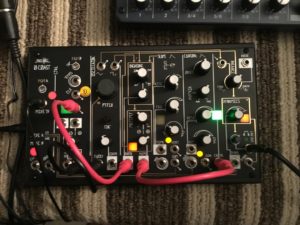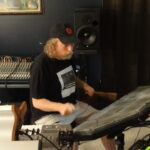Ever since watching the synth documentary, I Dream of Wires, analog synthesizers or even a Eurorack system were going to be part of my studio setup. Virtual analog synths from Korg and Waldorf still make their presence known on our recordings, but there’s no denying the superior tactile interface of a synth like the Moog Sub 37, let alone its otherworldly sound.
One way I’ve managed to avoid the cash rabbit hole of Eurorack is the Make Noise 0-Coast, a recent purchase. Its mixture of East Coast and West Coast architectural approaches offers a unique sound along with serving as a decent introduction to full modular synthesis. It’s well on its way to becoming a core part of the studio, while making a quite evil sonic pair with the Sub 37.
One Synth Patch at a Time
The 0-Coast comes with a MIDI connector as well as a small collection of patch cables which suffice to get you started on a journey to alien sonic vistas. A wall-wart power supply is also part of the package, so make sure your power strips have the extra room. There’s a simple introductory one-sheet with basic setup and patching information, with a full manual available online. Definitely add that to your near-term reading list.
As a semi-modular synth, the 0-Coast sports a host of normalized patch connections, which makes it easy to create a simple patch. The one-sheet features diagrams for a simple East Coast patch to be played over MIDI or CV, as well as a more esoteric drone. If you want to quickly get to experimenting, these two patches are more than enough to start.
A single oscillator synth, the 0-Coast’s triangle wave is the default (or normalized) waveform; you can also patch in the square wave as needed. Of course, both waveforms can be routed to other patch points for additional sonic trickery – an essential function of any modular synth.
A Clean Synthesizer Layout
The 0-Coast layout is easy to follow for both novice and grognard synthheads, with lines and arrows tracing the normalized and potential patch connections. The Contour circuit essentially serves as an envelope, while controlling dynamics, with the Slope circuit acting almost like an LFO when cycled. The latter also works at an audio rate; useful for patching up some oscillator sync action.
Instead of a subtractive filter, you use the Overtone and Multiply circuits to add harmonics or otherwise mangle the waveform in a sonically interesting fashion. Animate the sound by letting the Slope or Contour (or an external sequencer, like the Korg SQ-1?) modulate the Overtone or Multiply. Possibilities abound.
Clock is received from the MIDI input, or you can patch an external source to the clock input. Tapping to set the tempo is another useful option. A variety of color-coded “activity windows” serve nicely to indicate MIDI and Clock data a-fluttering, as well as the signal polarity at various points throughout the synth. The Stepped Random Output – part of the Math circuit – provides sample-and-hold functionality. I typically have it patched somewhere.
There is an even a separate MIDI input capable of a wide range of esoteric tasks. Accessing an internal menu system is necessary to change some of these deeper settings. You are also able to edit those using MIDI CC data.
As noted earlier, the 0-Coast warrants a full reading of the manual as well as copious amounts of patch experimentation. Make Noise’s YouTube channel is another great resource for learning more about the synth; be sure to watch all of their “Patch of the Day” videos.
If you have any level of curiosity about modular synthesis – Eurorack or not – the 0-Coast belongs in your synth collection. It serves as a perfect introduction to this vibrant and modern sonic world, while also standing alone as a valued contributor to any synth collection. Don’t be surprised if its purchase only leads to a full “Eurocrack” addiction. You are hereby warned.





[…] synthesizer focused on West Coast techniques, consider Ripplemaker to be the tablet-based cousin of Make Noise’s excellent 0-Coast desktop synth. Suitable for the creation of drones and other sonic atmospherics of doom, this is another […]